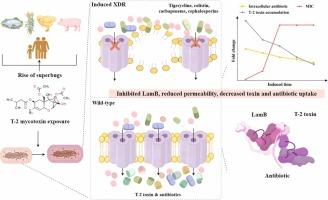Role and mechanism of the outer membrane porin LamB in T-2 mycotoxin-mediated extensive drug resistance in Escherichia coli
IF 12.2
1区 环境科学与生态学
Q1 ENGINEERING, ENVIRONMENTAL
引用次数: 0
Abstract
The influence of mycotoxins in ecological niches shared with antibiotic-resistant bacteria (ARB) remains underexplored. This study examined the impact of T-2 mycotoxin on the evolution of antibiotic resistance in Escherichia coli, highlighting the role of specific porins. Our findings revealed that exposure to 10 ng/mL of T-2 toxin induced multi-drug resistant (MDR) phenotypes in three E. coli. At 10-5 ng/mL, T-2 toxin caused E. coli ATCC 25922 to develop stable resistance to 13 critical antibiotics, with minimum inhibitory concentrations (MICs) increasing 16- to several thousand-fold. This resistance was linked to the downregulation of the mal gene cluster. Notably, T-2 toxin reduced membrane permeability by downregulating lamB, facilitating its own entry and reducing the intracellular accumulation of both the toxin and antibiotics, thereby enhancing resistance development. LamB mediated the XDR phenotypes in E. coli, particularly by blocking last-resort antibiotics such as cephalosporins, carbapenems, tigecycline, and colistin, complicating treatment strategies. LamB demonstrated high binding affinities for T-2 toxin and various antibiotics, with specific binding sites identified for meropenem (Arg134), imipenem (Ser148, Arg170, Lys129), ceftazidime (Phe106, Lys129), and cefepime (Tyr66, Gln267, Lys269), exhibiting binding energies of -2.93, -2.58, -2.53, and -4.3, respectively. These findings suggest that even low levels of T-2 mycotoxin pose a substantial public health risk. They underscore the urgent need to address these contaminants and open new avenues for antibiotic resistance research.

外膜孔蛋白 LamB 在 T-2 霉菌毒素介导的大肠杆菌广泛耐药性中的作用和机制
霉菌毒素在与抗生素耐药菌(ARB)共享的生态位中的影响仍未得到充分探索。本研究考察了T-2霉菌毒素对大肠杆菌抗生素耐药性进化的影响,强调了特定孔蛋白的作用。我们的研究结果表明,暴露于 10 毫微克/毫升的 T-2 毒素会诱导三种大肠杆菌产生多重耐药性(MDR)表型。在10-5纳克/毫升的条件下,T-2毒素会导致大肠杆菌ATCC 25922对13种关键抗生素产生稳定的耐药性,最低抑菌浓度(MIC)增加了16倍到数千倍。这种抗药性与 mal 基因簇的下调有关。值得注意的是,T-2毒素通过下调lamB降低了膜的通透性,促进了自身的进入,减少了毒素和抗生素在细胞内的积累,从而增强了耐药性的产生。LamB 介导了大肠杆菌的 XDR 表型,尤其是通过阻断头孢菌素、碳青霉烯类、替加环素和可乐定等最后的抗生素,使治疗策略复杂化。LamB 与 T-2 毒素和各种抗生素的结合亲和力很高,与美罗培南(Arg134)、亚胺培南(Ser148、Arg170、Lys129)、头孢他啶(Phe106、Lys129)和头孢吡肟(Tyr66、Gln267、Lys269)的特异性结合位点已被确定,其结合能分别为 -2.93、-2.58、-2.53 和 -4.3。这些研究结果表明,即使是低浓度的 T-2 霉菌毒素也会对公众健康构成严重威胁。它们强调了解决这些污染物的迫切性,并为抗生素耐药性研究开辟了新途径。
本文章由计算机程序翻译,如有差异,请以英文原文为准。
求助全文
约1分钟内获得全文
求助全文
来源期刊

Journal of Hazardous Materials
工程技术-工程:环境
CiteScore
25.40
自引率
5.90%
发文量
3059
审稿时长
58 days
期刊介绍:
The Journal of Hazardous Materials serves as a global platform for promoting cutting-edge research in the field of Environmental Science and Engineering. Our publication features a wide range of articles, including full-length research papers, review articles, and perspectives, with the aim of enhancing our understanding of the dangers and risks associated with various materials concerning public health and the environment. It is important to note that the term "environmental contaminants" refers specifically to substances that pose hazardous effects through contamination, while excluding those that do not have such impacts on the environment or human health. Moreover, we emphasize the distinction between wastes and hazardous materials in order to provide further clarity on the scope of the journal. We have a keen interest in exploring specific compounds and microbial agents that have adverse effects on the environment.
 求助内容:
求助内容: 应助结果提醒方式:
应助结果提醒方式:


